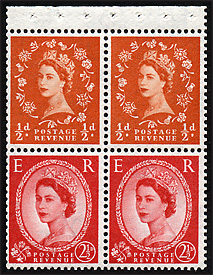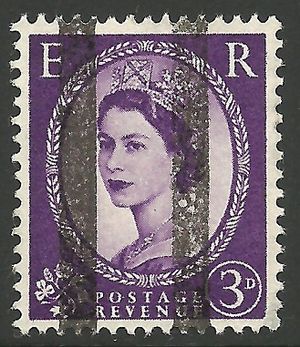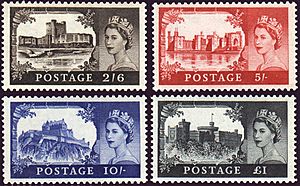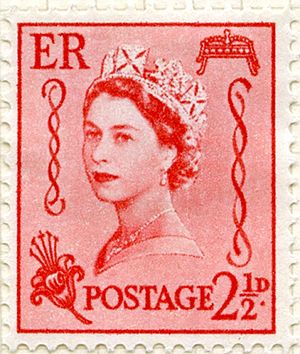Wilding series facts for kids
The Wildings were special postage stamps used in Britain from 1952 to 1971. They featured a famous photo of Queen Elizabeth II taken by Dorothy Wilding. These stamps were unique for a few reasons. They were the first British stamps to have special graphite lines on the back. They also had phosphor bands on the front. Both of these features helped machines sort mail automatically. The Wildings were also the first British stamps to show pictures on their higher values. Plus, they were the first to include special symbols for different regions of the UK.
Contents
How the Wilding Stamps Were Designed
The picture of Queen Elizabeth II on the Wilding stamps came from a photo taken on February 26, 1952. The photographer, Dorothy Wilding, had been working with the Royal Family since 1937. Many different ideas were considered for how to frame the Queen's portrait. Five main designs were chosen from artists like Edmund Dulac and Enid Marx.
The stamps also showed four symbolic flowers. These flowers represented each country in the United Kingdom. This idea was similar to some stamps from the time of King George VI.
In the photo, the Queen is wearing the George IV State Diadem. This is a special crown made for King George IV in the 1820s. It was also worn by Queen Victoria on stamps like the famous Penny Black. The original photo was slightly changed to make the crown appear more forward on the Queen's head.
Over time, people felt the Wilding portrait needed an update. Designers Michael Goaman and Faith Jacques suggested a new image in 1961. They thought the large Wilding portrait was hard to use on other stamps. They also felt the Queen's half-turned pose wasn't ideal. They wanted a design that represented the idea of the monarchy more than just the Queen herself. By 1963, a committee agreed a new design was needed. The Wildings were replaced in 1967 by the Machin series stamps. However, the Wilding design continued to be used for regional stamps until 1971.
Smaller Value Stamps
Eighteen different smaller value Wilding stamps were made. They ranged from 1⁄2d (halfpenny) up to 1s 6d (one shilling and sixpence). The first ones, the 1⁄2d and 2+1⁄2d, came out on December 5, 1952. All these stamps were printed using a method called photogravure. They also had small holes (perforations) around the edges, which were 15 by 14 holes per 2 centimeters.
Three different watermarks were used on these stamps:
- Tudor crown + E2R (from 1952 to 1954)
- St. Edward's crown + E2R (from 1955 to 1958)
- St. Edward's crown (from 1958 onwards)
These watermarks are often called 'Tudor Crown', 'St. Edward's Crown', and 'Crowns' (or 'Multiple crown'). The Tudor crown watermark was changed because the printing roller was getting old. The St. Edward's Crown watermark was changed later. This was partly because new regional stamps for Scotland were being introduced.
Sometimes, these stamps are found with the watermark upside down or sideways. This happened because of how they were cut from booklets or rolls.
The original paper for the stamps was cream-colored. But from April 1962, it was changed to white. This means you can find two versions of the 'crowns' watermark stamps. The 6d stamp can also sometimes be found on slightly pink paper.
Many of the stamps come in different shades of color. For example, the 2d stamp can be red-brown or dark red-brown. The 4d stamp can be found in two different blues. Also, the 2+1⁄2d red stamp has two slightly different designs. You can tell them apart by looking at the outline of the gem on the Queen's crown.
New Technology on Stamps
In 1957, a new system called Automatic Letter Facing (ALF) was tested. This system helped machines turn envelopes the right way for postmarking. The first version used graphite lines printed on the back of the stamp.
Later, in 1960, this system was updated. It started using phosphor bands on the front of the stamp instead. Phosphor glows under special light. At first, both phosphor and graphite lines were used. The first phosphor lines were 'green'. For technical reasons, 'green' phosphor was replaced by 'blue' phosphor in 1961. Finally, 'violet' phosphor was used from 1965. The main difference between these phosphors was how long they glowed after being lit up. 'Blue' glowed for 20 seconds, 'green' for 10 seconds, and 'violet' for 5 seconds.
Higher Value Stamps
In 1955, four larger, higher value stamps were released. These were known as the Castles. They were designed by L. Lamb. These were the first British stamps to truly show pictures. Before this, most designs were symbolic, like the 1953 Coronation stamps. The Castle stamps showed the Wilding portrait of the Queen along with a picture of a castle. The four stamps were:
- 2s 6d (two shillings and sixpence) — Carrickfergus Castle
- 5s (five shillings) — Caernarvon Castle
- 10s (ten shillings) — Edinburgh Castle
- £1 (one pound) — Windsor Castle
These stamps were printed using a method called recess printing. They were printed on different types of paper by three different companies over the years. They also used two watermarks: St. Edward's Crown and Crowns. All these stamps had perforations of 11 by 12 holes per 2 centimeters.
Regional Stamps
Special regional stamps, also known as Country Definitives, were first introduced in 1958. These were made for Northern Ireland, Scotland, Wales, Guernsey, Jersey, and the Isle of Man. While all these stamps featured the Wilding portrait of the Queen, their frames were different. They included symbols unique to each region, like the Scottish thistle or the Welsh dragon.
These regional stamps stayed in use longer than the national Wildings. The stamps for Guernsey and Jersey were stopped in 1969. This was when these islands became independent for postal services. The other regional stamps were stopped when Britain switched to decimal currency in 1971. Because they were used longer, some later regional stamps had no watermark, just like the Machin stamps. Other technical details were similar to the national Wilding stamps.
What Happened to the Wilding Stamps
After Britain changed to decimal currency in 1971, most old stamps with pre-decimal values became invalid. This happened on March 1, 1972. This included almost all the Wilding stamps. However, the £1 stamps from the 1952 high value series remained valid for use.
Other Places Wilding Stamps Were Used
Besides the United Kingdom, Wilding stamps were also used in other places. Both the smaller and higher value stamps were overprinted. This means they had extra printing on them for use in North Africa (like Morocco Agencies and Tangier) and the Middle East (like Bahrain, Kuwait, Muscat, and Qatar).
Remembering the Wildings
The Wilding stamps have been remembered over the years. In 1998, the British Post Office made a special booklet. It contained new Wilding-style stamps with decimal currency values. In 2002 and 2003, small sheets of stamps were released that also looked like the Wildings. In 2012, for the Diamond Jubilee of Elizabeth II, the Royal Mail issued a commemorative sheet of stamps. One of these stamps featured photography by Dorothy Wilding, based on her original 1952 design.





